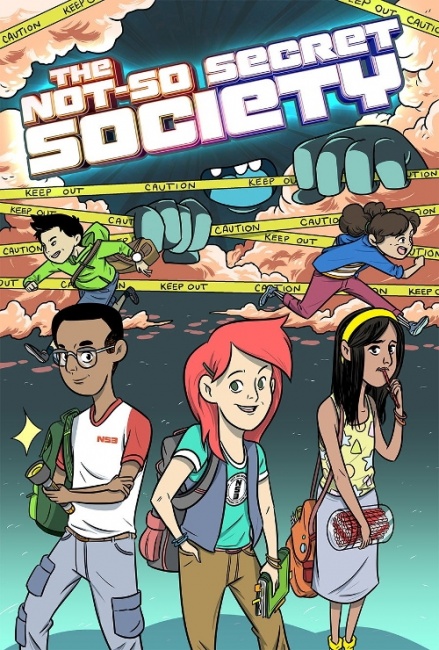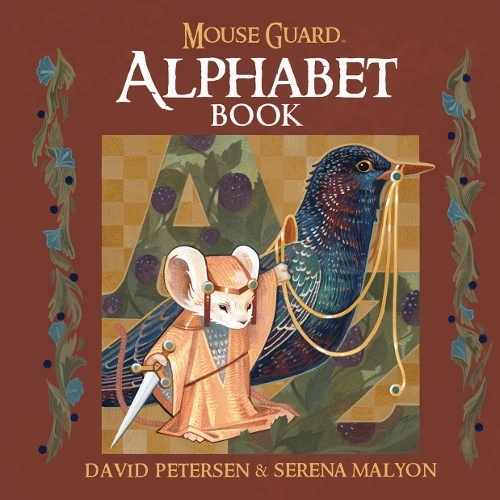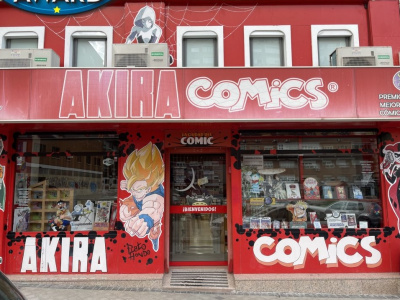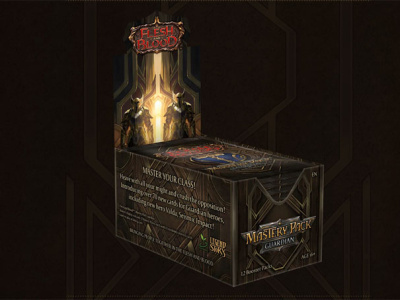ICv2 recently spoke with BOOM! Studios President of Publishing and Marketing Filip Sablik to hear his views on the overall and kids markets, format, age segmentation, trending properties and segments, how Scholastic Book Fairs can be an opportunity for stores, and BOOM!’s biggest kids releases for the rest of 2017.
ICv2: Maybe you could start out by focusing on the broader market first. What are you seeing in the comics and the graphic novel market overall?
Filip Sablik: Broadly speaking, the book market is still an area of growth for us, and I think for a lot of publishers. Because the content has gotten broader and more diverse, it's opened up new avenues.
I think BOOM!, certainly, and a number of other comic publishers are starting to broaden the types of formats and publishing categories that they're experimenting with. That's creating some new opportunities.
The Direct Market? Our perspective on it is that we've had an amazing last four or five years. We're continuing to have a really good year this year, but we definitely see more challenges in the Direct Market in terms of the saturation of product, as well as retailers feeling a little bit fatigued by certain sales strategies being utilized by publishers.
That's something that we're trying to tackle head on, and address with the BOOM! Guarantees that we announced back in February, and work with our retailer partners in the Direct Market to make sure that this is another good year for them, at least with us.
On the book market side, is the growth all Amazon, or are you also getting some growth from Barnes & Noble with their new displays?
I can only speak to our perspective. Our growth has surprisingly not been with Amazon. The Amazon sales have grown, but we've seen a big uptick in sales through Baker & Taylor and Ingram, which as near as I can tell, is being driven in large part by libraries.
Barnes & Noble has always been a solid supporter of ours, but we've continued to see our sales grow with them. It's reasonable to assume that some of that is coming from the new displays and the new approach.
Let's focus down more narrowly now on the kids' market. What's that been doing over the last year, and how is that different or the same as the broader market?
Historically, our experience with the kids' material that we publish is that it ends to be stronger in the book market than the Direct Market. That's definitely continued to be the case for us. KaBOOM! continues to be one of our strongest imprints.
What we definitely have noticed is that the book market has continued to grow and show willingness to take on additional SKUs. The Direct Market seems more saturated. Some of our energy is shifting more towards direct‑to‑graphic novel formats, as opposed to single issues, and then being collected into softcover and hardcover editions for the book market.
We've also seen a fair amount of growth over the last few years on the Boom Box! side. As both of those imprints have continued to organically develop, we're seeing the audience being a little bit better defined as we move forward.
KaBOOM! has naturally evolved into a middle grade and younger imprint for us. Boom Box! is evolving over time into more of a YA‑focused imprint. In the meantime, we do have titles in that imprint that appeal to middle grade readers and younger. Same thing with Archaia. We continue to publish things there that appeal to younger readers.
Lumberjanes and Adventure Time continue to be our biggest brands in both markets, in both book market and Direct Market.
We talked a year ago about format, and whether the periodical format was a good fit for comics for younger readers (see “ICv2 Interview: BOOM!’s Filip Sablik”). You said it was. This time around, it sounds like you're trending a little more toward the graphic novel format. Have you changed your opinion, or is it an incremental change?
It's an incremental change, but as always, it's listening to the marketplace. They're telling you what they're looking for. What we're seeing from the Direct Market is signals that would indicate that they're more excited about complete stories and graphic novels.
We're certainly also continuing to reevaluate the trim size, page count, and things like that to figure out what is the consumer responding to most favorably. Our point of view specifically with KaBOOM! and Boom Box! is that we're not seeing anything that would tell us that we need to reduce the number of single‑issue SKUs that we're putting out.
As we're adding properties and adding new stories, we're more and more looking at having those as graphic novels.
Age segmentation was actually one of the things that we wanted to drill down on a little bit this year. Do you have actual age ranges that those imprints are targeted toward?
We're always refining. As a company that was natively created and grew up in the Direct Market, some of this is still a process of educating ourselves, our staff, and our creators in terms of maybe thinking a little bit closer with book trade norms.
Broadly speaking, we tend to look at the material that we put out through KaBOOM! as being targeted at 8‑ to 12‑year‑olds, and then Boom Box! 13- to 18- maybe up to 20‑year‑olds.
What about something like Power Rangers?
One of the reasons that that is in our Studios imprint, which tends to be focused primarily on an older reader, is because the iteration of Power Rangers that we've been creating stories for is Mighty Morphin Power Rangers, which is over 20 years old. The core audience for that particular series tends to be in their mid to late 20s, up into their early 30s. I know that the entire series is available on Netflix. Certainly, it does have members of its audience that skew younger, but that's our target audience, is the folks that saw it in the early '90s that really fell in love with it.
You don't consider that a kids title?
No, I think in general, our publishing philosophy has always been as much as possible to make all of our content accessible to readers of all ages.
There's nothing in there that is inappropriate for a younger reader, but I think the scale and the scope of the storytelling, and its connection with the original continuity, tends to make it a little bit more exciting, a little bit more appealing for an older reader.
You mentioned a couple of properties that continue to do well. What's trending in terms of what are you seeing an uptick in over the last six months? We’re interested in licensed or house properties.
On the licensing front, both Steven Universe and Amazing World of Gumball have continued to grow for us. Steven Universe, primarily in the Direct Market, in the book market, and in channels like Barnes & Noble.
As that show continues to grow its audience and define what it is, it's attracting new fans and folks that are interested in getting additional story content through other mediums. Amazing World of Gumball is something that we've found a lot of success with working with Scholastic Book Fairs.
It's a property that appeals for their audience. In the last couple years, it's really taken off.
How many volumes are there of Amazing World of Gumball?
I want to say, I'm going to look at my shelf here a moment. We are up to five or six volumes at this point.
When Scholastic takes it, do they take all of them, or just Volume 1?
They're selective. Usually, they're most interested in what the new volume is that's coming out. It's one of the interesting things about that market, is it doesn't seem to be a barrier if they didn't carry Volume 1. People seem to be willing to jump in.
That being said, most of the things that we do that's targeted for younger readers are packaged in standalone volumes. Using Gumball as an example, the graphic novels that we put out there don't have volume numbers on them.
They're just subtitled with whatever the particular story is. I think that makes it a little bit easier to jump in midstream.
One of the reasons we were asking is that it's been suggested that there's an opportunity for brick and mortar retailers. After the Book Fairs have been through town, they seed the market with a volume or two of a multi‑volume series, and people start looking for the rest of the series.
Just anecdotally, as a parent with two young kids, I absolutely think that's true. Certainly, a logical leap would be that those parents are then going to Barnes & Noble and Amazon to fill in the gaps, but I think there's a real opportunity for local comic shops to engage and take advantage of that.
What parts of the kids market are you seeing grow the fastest right now?
That's a great question. I would say that broadly speaking, we're still seeing the most growth with young female readers. Definitely, the titles that appeal most to them are the ones that are really taking off.
Lumberjanes continues to grow. Goldie Vance from the Boom Box! imprint was something that really seemed to strike a chord when we launched that in the book market. Particularly with Boom Box! (less so with KaBOOM!), there's a growing audience of young LGBTQ fans that are looking for stories that are reflective of their experiences and representative of that.
One of the things that we've worked really passionately on is putting out series that have queer representation in all‑ages content, so that it's reflective of the world around us.
What do you expect to be your biggest releases for the rest of the year?
On the Direct Market side, we're doing a partnership with Dynamite. They're putting out the Grumpy Cat/Garfield crossover this summer that we expect is going to be something that attracts a lot of eyeballs. We're really excited to be able to shine a spotlight on Garfield within the Direct Market.
I expect that, when that is collected, it will do quite well, both in the book market, and potentially in other places. Then we have another crossover event that we're doing that we'll be publishing this summer. That'll be announced shortly, that I'm very excited about, but I can't [laughs] reveal quite yet.
Those are the two things on the Direct Market side. We have a new licensing partner that's going to be coming on in Fall under the KaBOOM! imprint that we're very excited about. In terms of things that we have announced, one of the more exciting properties that we have coming up in the original graphic novel space is in July.
We have a property called The Not‑So Secret Society that we're putting out with our friends at Macrocosm, the team that put together Lantern City for us under the Archaia imprint (see “Archaia’s Transmedia Steampunk Comic”).
This is a middle grade series that is about a group of kids who live in high rise apartments in an urban setting. They come from all sorts of different backgrounds, and they band together to solve problems and have adventures. What makes them unique is most heroic societies try to do things behind the scenes, save the world, and do so in secret. What's fun is, because these are young kids, they actually want everyone to know about the things that they're doing and the heroic adventures they're having. Of course, because they're very outlandish and fantastical, no one believes them.
They're running around, having adventures with supernatural events, and taking on challenges. The series is about teamwork and about finding your group of friends. The two writers behind it, Matthew and Arlene Daley, before writing this series, they actually have, combined, a couple decades worth of teaching experience that they're bringing to the table.
They're working really hard to develop classroom material. They've built out a really fantastic website with a ton of resources and activity pages and are working hard to make this something that educators and librarians, particularly in urban settings, can hand kids.
One of the things they observed was that there weren't that many comic book properties that featured multicultural groups of kids in urban settings. A lot of times, it's either monocultural or in suburban, middle America settings.
They were looking to create something that would appeal to those kids that are growing up in New York, Los Angeles, and large cities around the country.
There's a lot of them, so that makes sense.
We've got a couple young readers and early readers books that we're putting out. Actually, both of the ones I'm looking at are coming out through our Archaia imprint. The first is called An Apple and An Adventure, which is going to be out in June.
It is an alphabet book that stars a young cave girl and her best friend, who's a triceratops. It's by this amazing cartoonist named Martin Cendreda, who's local here to Los Angeles. He showed us a sample, and we just fell in love with it.
It's really sweet, cute, and full of whimsy and beautiful artwork. Parents that are looking for an alphabet book, they're going to be really excited when they see it.
Our second alphabet book is going to be coming from David Petersen, who's doing a Mouse Guard alphabet book. That'll be out in September. It's something that he's really excited about. He brought in a new illustrator to work with him on that. It's the first time, I think, that he's had anybody work alongside him on Mouse Guard, outside of the few short stories that he did for the Legends of the Guard. The illustrator's name is Serena Malyon.
One of the things David wanted to do was to continue to expose younger and younger readers to Mouse Guard, and use this alphabet book as a way to also reflect the values that he sees are thematic in Mouse Guard.

2017 Update on the Market and BOOM!’s Kids Titles
Posted by Milton Griepp on May 9, 2017 @ 6:30 am CT
MORE COMICS
Also: Longtime Eisner Awards Administrator Jackie Estrada to Retire
July 26, 2025
Jackie Estrada, who has been running the awards since 1990, is stepping down.
Second Win for Akira Comics
July 26, 2025
Akira Comics previously won the award in 2012.
MORE NEWS
Shop Talk, July 2025
July 25, 2025
All this and more in this month's edition of Shop Talk, our roundup of retailer news.
Supplementary Booster Set for the Guardian Class
July 25, 2025
Legend Story Studios will release Mastery Pack Guardian, a supplementary booster set for Flesh and Blood TCG, into retail.











